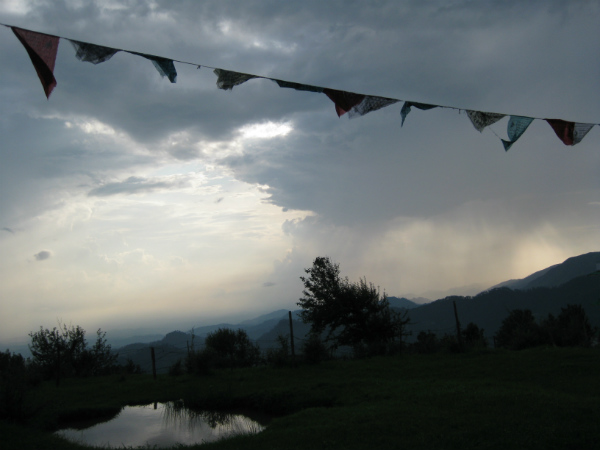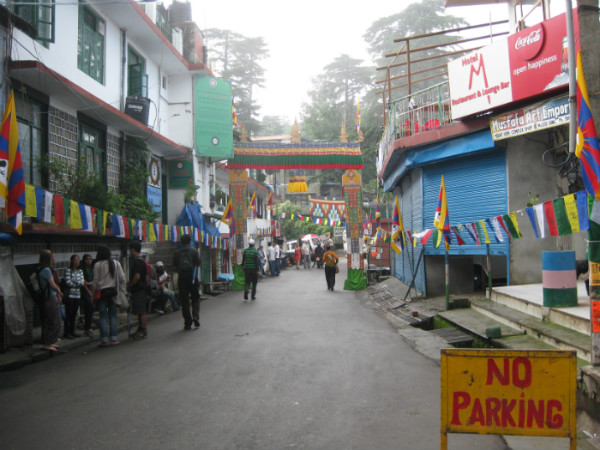Tibetan nuns hanging prayer flags in Dharamsala, India, seat of the Tibetan Government in Exile, and home of His Holiness the Dalai Lama and a thriving refugee community.
T
ibetan prayer flags are hung in the thin cold air of mountain peaks where the wind will carry their blessings out across a vast dry land. They are called lungta, Tibetan for windhorse. The bold colors—blue, white, red, green, yellow—prick out amidst the wash of tan and gold and lavender of this wide and empty moonscape. See the wind nipping, teasing, pulling at the tiny colored threads. See the horses break free, run thundering down the valleys, long tails streaming, braiding behind them.
When the flags have given all their colors to the wind and sun, worn to near-translucence, they are removed from circulation among the unclean things of this world and set alight in smoldering little heaps. Released from the materiality of bodies, they return to the elements, dissolve back into the rivers and the stones. Burning is the proper way to dispose of that which is sacred. It is to acknowledge the essential transience of life. As the flames lick the faded fabric of the flags, even then, the smoke carries their blessings into the world. Shadow horses on the wind cross borders unchecked.
Tibetans burn books, blessing cords, and images of His Holiness the Dalai Lama. But historically, Tibetans have burned bodies only rarely. Flags, books, and photographs give themselves quickly to the fire, but bodies require additional fuel before they will catch flame. Trees are skinny and scarce on the Tibetan plateau, and dried pats of yak dung must be saved to warm the cooking stoves. In the past, cremation was reserved for high lamas, and because burial is impossible in the frozen Tibetan plateau, for centuries, Tibetans have practiced sky-burial. Corpses are cut apart, the pieces spread in a high, wide place to be taken up by vultures, vanishing into the blue.
Charred silhouettes streaming flames, they run through town squares, past temples and government offices, dying with their hands raised in prayer, “freedom” on their lips.
Throughout the half-century of Chinese occupation, the ceremony has been banned or heavily regulated. Such ritual dismemberment allows priests and witnesses to examine bodies up close, sometimes revealing hidden injuries in protestors and dissenters who have been detained by Chinese security forces. Though the Chinese have built modern crematories to dissuade from the tradition, many Tibetans still prefer sky-burial.
But in the last four years, the wind sweeping through the Tibetan plateau has more frequently carried the sharp odor of burning flesh and kerosene. On February 7, 2009, a twenty-year-old monk named Tapey from the Kirti monastery in eastern Tibet ran into the streets in heavy, gasoline-soaked maroon robes, and lit a match. He held a Tibetan flag and a photograph of His Holiness the Dalai Lama above the flames until he was shot down by Chinese military police. On March 16, 2011, Phunstog, a twenty-one-year-old monk from the same monastery, cried out for the long life of His Holiness the Dalai Lama as his body ignited. After extinguishing the fire, police beat the monk in the street until he died. On August 15, 2007, a twenty-nine-year-old monk in Tawu drank petrol before lighting the match. Two brothers, ages 18 and 19. A nun, age 20. A boy, age 18. A girl in a vegetable market. A mother of four, a father of three, an old nomad.
Since 2009, more than 120 Tibetans have set themselves aflame to protest the Chinese occupation of their homeland. Charred silhouettes streaming flames, they run through town squares, past temples and government offices, dying with their hands raised in prayer, “freedom” on their lips.
On December 19, 2013, Tsultrim Gyatso became the 125th recorded self-immolation inside Tibet. In his suicide note, he wrote:
Foreign journalists are banned from Tibet and even private tourists have access only through government-arranged tours, their movements carefully controlled. Some areas are blocked entirely to the outside world. This makes independent reporting on the self-immolations impossible, stories dependent on unconfirmed reports and anonymous sources. Messages are conveyed to Tibetans living in exile in India and Nepal through crackling radio connections , coded phone calls, and memory cards smuggled across the mountains. By the time they reach the world, stories are tangled and dulled through many retellings. Of the 100th recorded self-immolation, the New York Times wrote: “Another advocacy group… reported that monks living in exile in India who had received word of the self-immolation had said that during the act, Mr. Lobsang Namgyal called for the long life of the Dalai Lama…”
A man in the Kham region of Tibet said to his friend in exile, “If we protest we are thrown into prison, where we are mistreated, get sick and die. We prefer to die for freedom at our own hands and on our own terms.”
To burn themselves is to take charge of their own bodies, to go up in a blaze and slip beyond the reach of the military police and the reeducation campaigns and the forced loyalty pledges. Yet the unlucky ones do not slip far enough. The first monk to self-immolate, Tapey, didn’t die from the flames and he didn’t die from the bullets of the military police. At a local hospital, doctors attempted to amputate his legs and right arm to remove evidence of the bullets; his mother prevented them. Tapey’s condition and whereabouts remain unknown. He is one of more than ten self-immolators who have disappeared after being taken into custody by military police. Others who have died quickly have been disposed of by authorities in rushed and secret cremations.
The colors of the prayer flags signify the five Tibetan elements—blue for sky, white for air, red for fire, green for water, and yellow for earth. When balanced, the elements are believed to grant harmony both internally and externally. But in recent months, village monasteries in rural corners across Tibet are flanked only by red flags against a too-blue sky. These are not the lungta, red for fire, but the red starred banner of China.
Whipped across a plain of dry grass, a signal fire can grow into an uncontrollable wildfire; the flames can engulf everything.
The Tibetans are tearing these flags down from the monasteries, stomping them into the yellow dusty earth, throwing them into the green rivers. They refuse to fly the red starred banner from the flat roofs of their mud and stone homes. Those accused of taking down the Chinese flag have been threatened, beaten, and detained by authorities.
Some of the self-immolators carry the banned Tibetan flag, on which a pair of snow lions crouches before a snowy peak and radiant sun. Each self-immolation is followed by an intense security crackdown on the area by Chinese officials. Family and friends of the protestors are questioned and threatened. Cell phones are confiscated, internet service is disconnected, and Chinese paramilitary forces stationed at crossroads monitor the movements of Tibetans.
In exile, where survival is both prayer and politics, prayer flags and laundry lines crisscross the sky, tangled rainbows. Children who have never known their homeland dream of mountains higher and drier than they can imagine. They carry candles for the self-immolators, and their songs rise up into the night.





